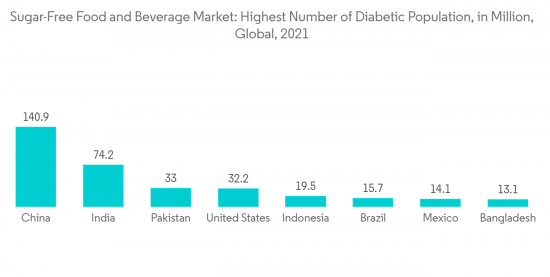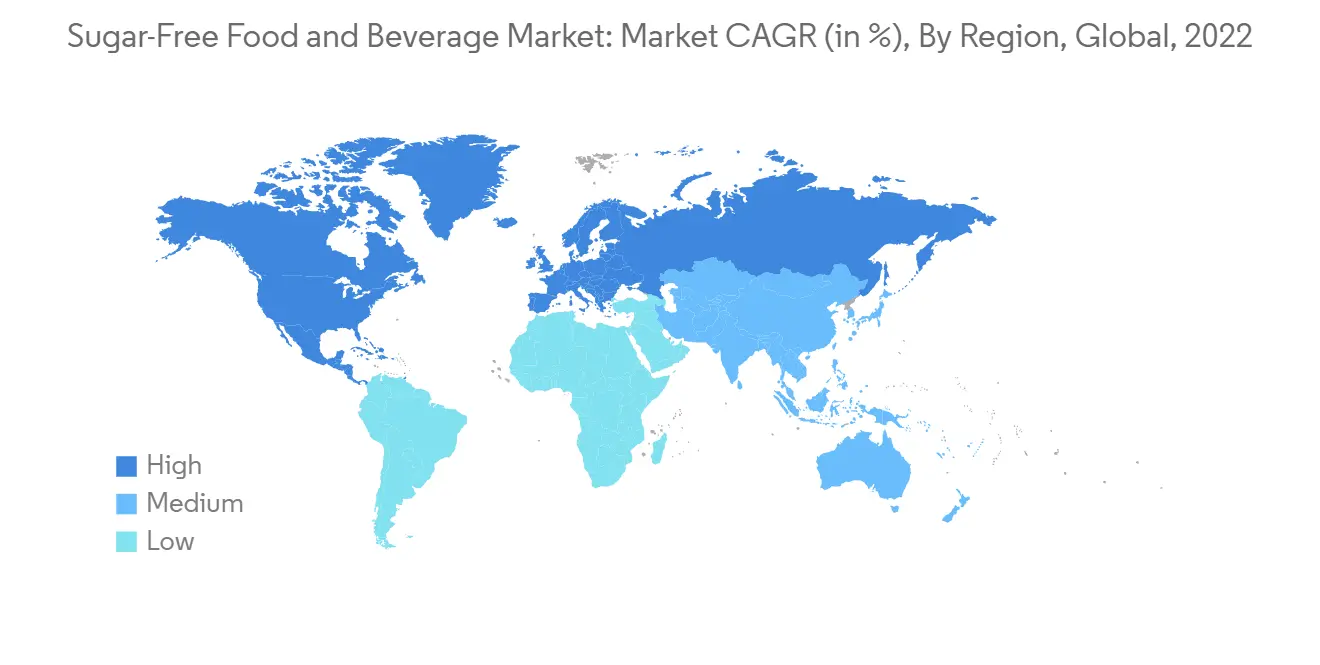PUBLISHER: Mordor Intelligence | PRODUCT CODE: 1333722

PUBLISHER: Mordor Intelligence | PRODUCT CODE: 1333722
Sugar-Free Food And Beverage Market Size & Share Analysis - Growth Trends & Forecasts (2023 - 2028)
The Sugar-Free Food And Beverage Market size is expected to grow from USD 19.17 billion in 2023 to USD 23.30 billion by 2028, at a CAGR of 3.98% during the forecast period (2023-2028).
Key Highlights
- As people have learned more about the negative effects of eating improperly processed food, they have become more selective about what they put in their bodies. The move from a conventional to a health-conscious outlook has encouraged producers to expand their product lines with novel, high-quality goods. Products that claim to be dairy, lactose, gluten, or sugar-free tend to be the most widely available.
- For instance, in February 2021, Halsa expanded its product line with the addition of 24oz family-size plain unsweetened zero Sugar oat milk yogurt. The new zero-sugar oat milk yogurt has only 90% calories per serving and has multiple uses as a base for making healthy probiotic smoothies, dips, sauces, salad dressings, and many other plant-based recipes at home.
- Mounting incidences of diabetes and overweight/obesity are pushing consumers from sugar and toward sugar-free alternatives. Both conditions are prevalent. The American Heart Association recommends no more than six teaspoons of added sugar a day for women to be safe from diabetes and obesity.
- Moreover, less sugar prevents glycation. Consequently, obesity caters to a significant percentage of total health expenditure in many countries. According to the analysis of the Organization for Economic Co-Operation and Development (OECD), the percentage of health expenditure spent on overweight and related conditions is predicted to account for 14% in the United States from 2020 to 2050.
- Moreover, the increasing demand for low-calorie beverages and the associated cost-cutting advantage of using sugar substitutes is perhaps considered to be the foremost reason for the growth of the sugar-free foods and beverages market. The growing demand for sugar-free products might also be attributed to the increasing acceptance of veganism and plant-based diets. People who adhere to these diets often search for food and drink options that don't contain any animal ingredients and have low sugar content. Companies in the food and drink industry are responding to this trend by releasing more sugar-free options.
Sugar-Free Food and Beverage Market Trends
Rising Concern About Lifestyle Diseases
- Food and beverage products contain many calories and sugar content. Owing to this factor, health-conscious consumers try to consume low-calorie and no-sugar food products. Meanwhile, the increasing prevalence of obesity is anticipated to increase the sales of sugar-free food and beverages in the market over the forecast period. Over the last decade, the prevalence of overweight and obesity has increased.
- North American countries such as the United States recorded 31.9% population aged 18 and over being overweight as per the Centers for Disease Control and Prevention agency data. As sugar-containing products are high in calories, several consumers in the market prefer no added sugar or sugar-free products like juices, biscuits, dairy products, and others. Similarly, the increasing diabetic population in the region is further driving the sales of sugar-free food and beverages.
- According to the International Diabetes Federation (IDF), in 2021, 51 million people in North America and the Caribbean lived with diabetes. Thus, the increasing diabetic population is inclining toward sugar-free bakery products like biscuits, cookies, muffins, etc.
- Some of the benefits of reducing sugar intake include it helps in losing weight and preventing obesity, lowers the risk of type 2 diabetes or pre-diabetes, and reduces the risk for inflammatory digestive conditions such as irritable bowel disease and Crohn's disease. The low-carb beverages are designed to provide sustained energy and help accelerate the metabolic state. Therefore this factor is driving the growth of the market. New product innovation with attractive packaging is the main strategy adopted by players.
- For instance, in September 2021, Mondelez International launched a new line of sugar-free Oreos in China. The Oreo biscuits contain maltitol instead of sucrose and glucose. Two products on sale are the "classic" Oreo flavor and rose-flavored Oreo zero thin biscuits that have a floral taste with a crispy texture.

North America Holds Largest Market
- The World Health Organization (WHO) found that a rise in fast food sales is correlated to a rise in body mass index, and Americans are very much fond of fast foods. Rising concerns regarding obesity and diabetes through extensive awareness means consecutively generating the demand for healthier food and beverage products in the market. In 2022 around 5% and 3% of people in the United States are suffering from obesity and diabetes, according to a survey conducted by Research America, creating a promising demand for sugar-free food and beverage market in the United States.
- US consumers, therefore, accepted the sugar-free concept offerings very well. So the manufacturers commenced repositioning and validating the recipe of the products as the primary strategy to serve the diverse demands and strengthen the consumer base. For instance, in March 2022, MusclePharm, a global provider of leading sports nutrition and lifestyle branded nutritional supplements, launched a high whey protein drink line (Ready-To-Drink protein drink) with over 20 g of protein in multiple sugar-free flavors.
- Most food product categories have established markets, and there is great room for volume growth of free-from food products. The key players in the market are focused on offering new products and expanding their presence in the country, attracting a larger customer base. These players offer no added sugar in plant-based food and beverages, catering to the growing consumer requirement for vegan and sugar-free alternatives.
- For instance, in February 2021, Nadamoo!, a dairy-free coconut milk ice cream company, launched its no added sugar flavors of ice creams in the United States. The new products were available in four flavors: vanilla, chocolate, mint chip, and strawberry. The company also claimed the product to be certified non-GMO and gluten-free.

Sugar-Free Food and Beverage Industry Overview
The global sugar-free food and beverages market is highly competitive, with the presence of many players across the world. High investments in R&D activities and product innovation have led them to gain a major market share in the global market. Some of the key players in the market include The Hershey Company, Nestle S.A, PepsiCo, Mars Incorporated, and the Kellogg Company.
The key players are embarking on mergers and acquisitions in the market to expand their portfolio and cater to the interests of local consumers, and concentrate on acquiring new leading brands. Some of the players are also using social media platforms and campaigns for marketing and promoting their products. For instance, in March 2022. Coca-Cola India launched a new campaign for its new brand Coca-Cola Zero Sugar.
Additional Benefits:
- The market estimate (ME) sheet in Excel format
- 3 months of analyst support
TABLE OF CONTENTS
1 INTRODUCTION
- 1.1 Study Assumptions and Market Definition
- 1.2 Scope of the Study
2 RESEARCH METHODOLOGY
3 EXECUTIVE SUMMARY
4 MARKET DYNAMICS
- 4.1 Market Drivers
- 4.2 Market Restraints
- 4.3 Porter's Five Forces Analysis
- 4.3.1 Bargaining Power of Suppliers
- 4.3.2 Bargaining Power of Buyers/Consumers
- 4.3.3 Threat of New Entrants
- 4.3.4 Threat of Substitute Products
- 4.3.5 Intensity of Competitive Rivalry
5 MARKET SEGMENTATION
- 5.1 Product Type
- 5.1.1 Beverage
- 5.1.2 Dairy and Dairy Alternatives
- 5.1.3 Confectionery
- 5.1.4 Bakery Products
- 5.1.5 Dietary Supplements
- 5.1.6 Other Product Types
- 5.2 Distribution Channel
- 5.2.1 Supermarkets/Hypermarkets
- 5.2.2 Convenience Stores
- 5.2.3 Pharmacies/Drug Stores
- 5.2.4 Online Retail Stores
- 5.2.5 Other Distribution Channels
- 5.3 Geography
- 5.3.1 North America
- 5.3.1.1 United States
- 5.3.1.2 Canada
- 5.3.1.3 Mexico
- 5.3.1.4 Rest of North America
- 5.3.2 Europe
- 5.3.2.1 Spain
- 5.3.2.2 United Kingdom
- 5.3.2.3 Germany
- 5.3.2.4 France
- 5.3.2.5 Italy
- 5.3.2.6 Russia
- 5.3.2.7 Rest of Europe
- 5.3.3 Asia-Pacific
- 5.3.3.1 China
- 5.3.3.2 Japan
- 5.3.3.3 India
- 5.3.3.4 Australia
- 5.3.3.5 Rest of Asia-Pacific
- 5.3.4 South America
- 5.3.4.1 Brazil
- 5.3.4.2 Argentina
- 5.3.4.3 Rest of South America
- 5.3.5 Middle-East and Africa
- 5.3.5.1 South Africa
- 5.3.5.2 Saudi Arabia
- 5.3.5.3 Rest of Middle-East and Africa
- 5.3.1 North America
6 COMPETITIVE LANDSCAPE
- 6.1 Most Adopted Strategies
- 6.2 Market Share Analysis
- 6.3 Company Profiles
- 6.3.1 The Hershey Company
- 6.3.2 Nestle SA
- 6.3.3 The Kellogg Company
- 6.3.4 Mars, Incorporated
- 6.3.5 PepsiCo Inc.
- 6.3.6 The Coca-Cola Company
- 6.3.7 The Kraft Heinz Company
- 6.3.8 Hostess Brands, Inc.
- 6.3.9 Mondelez International Inc.
- 6.3.10 Strauss Group Ltd
- 6.3.11 Meadbery
7 MARKET OPPORTUNITIES AND FUTURE TRENDS




